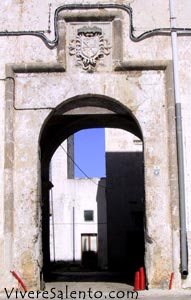|
|

| Inhabitants’name: Tavianesi |
The civic coat of arms
of Taviano has a red background and it represents a palm branch. There are no
 certain
historical news about the origins of this small town but the human presence on
this territory during the Neolithic Age is testified by a menhir and a dolmen.
The menhir was called "Crucicchie" and it was 2.50 metres tall. Now nothing has
left of this menhir except for a modest documentation. The dolmen is named after
the place where it is situated, “fondo specchi”. According to some historians
this centre was built by the Cretans while for others it was founded during the
Roman domination. Probably this lands were given to the centurion Octavianus for
his courage on the battleground. He built hiw own house and that of his soldiers
and later the village became bigger and bigger. An other hypothesis is that the
first centre was founded by Caesar Octavianus, the first Roman emperor. However
the Roman origins of Taviano are proved by the recoveries of Roman graves and
Byzantine coins. The feudal age started in 1190, when the Norman king Tancredi
gave the feud to Ottavio Foggetti, that became the first Earl of Taviano. In the
XIII century Taviano was ruled by the descendants of the Foggetti family, while
in the XIV century it was governed by the Manuppellos, the Del Balzos, the dell'
Amendoleas, the Minutolos and the Brunswichs. In the XV century the small town
was under the control of the Orsini Del Balzos and later of the Borbones. From
the XVI century to the following one there were the Foggettis again, and then
the De Franchis and the Personès. The last vassals were the Caracciolos, that
governed the centre until the abolition of the feudal system. The most
well-known people of Taviano are: Alberto Ferruccio Piccinni (lawyer), Angelo d'
Ambrosio (a chemist), Filippo Lanzano (notary), Sancia Foggetta (abbess), Vito
Ippazio Previtero (a man of letters and priest), Onofrio Scategni (lawyer) and
Alberto De Blasi (surgeon). certain
historical news about the origins of this small town but the human presence on
this territory during the Neolithic Age is testified by a menhir and a dolmen.
The menhir was called "Crucicchie" and it was 2.50 metres tall. Now nothing has
left of this menhir except for a modest documentation. The dolmen is named after
the place where it is situated, “fondo specchi”. According to some historians
this centre was built by the Cretans while for others it was founded during the
Roman domination. Probably this lands were given to the centurion Octavianus for
his courage on the battleground. He built hiw own house and that of his soldiers
and later the village became bigger and bigger. An other hypothesis is that the
first centre was founded by Caesar Octavianus, the first Roman emperor. However
the Roman origins of Taviano are proved by the recoveries of Roman graves and
Byzantine coins. The feudal age started in 1190, when the Norman king Tancredi
gave the feud to Ottavio Foggetti, that became the first Earl of Taviano. In the
XIII century Taviano was ruled by the descendants of the Foggetti family, while
in the XIV century it was governed by the Manuppellos, the Del Balzos, the dell'
Amendoleas, the Minutolos and the Brunswichs. In the XV century the small town
was under the control of the Orsini Del Balzos and later of the Borbones. From
the XVI century to the following one there were the Foggettis again, and then
the De Franchis and the Personès. The last vassals were the Caracciolos, that
governed the centre until the abolition of the feudal system. The most
well-known people of Taviano are: Alberto Ferruccio Piccinni (lawyer), Angelo d'
Ambrosio (a chemist), Filippo Lanzano (notary), Sancia Foggetta (abbess), Vito
Ippazio Previtero (a man of letters and priest), Onofrio Scategni (lawyer) and
Alberto De Blasi (surgeon).
|